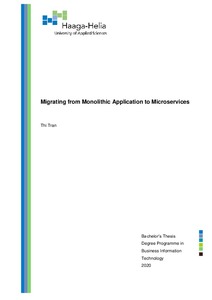Migrating from Monolithic Application to Microservices
Tran, Trong Thi (2020)
Tran, Trong Thi
2020
All rights reserved. This publication is copyrighted. You may download, display and print it for Your own personal use. Commercial use is prohibited.
Julkaisun pysyvä osoite on
https://urn.fi/URN:NBN:fi:amk-2020052714294
https://urn.fi/URN:NBN:fi:amk-2020052714294
Tiivistelmä
The following work focuses on the concept of microservices and the adoption process from monolithic application to microservices.
Microservices has been proven to be a preferable choice for enterprises to develop software. About 84% of organizations have embraced microservices architecture to accelerate innovation efforts and stay competitive. However, the migration process to microservices is not clear for organizations. 32% of organizations admit that difficulty integrating with monolithic legacy apps remains a challenge for their microservices adoption.
This work shows how the migration process to microservices can be applied practically by implementing a case study on an eCommerce store. The work uses and describes in detail Strangler pattern as well as with the service domain as a framework for implementation. In the end, there will be an evaluation using a monitoring system from Postman to determine the availability and resilience of the system during the migration process.
Results collected from the monitoring system are discussed and analyzed. They show that using Strangler pattern in migration process keeps the system availability over 97%, including system configuration and user errors. This result shows that Strangler pattern works well as a migration process method and allows organizations to have an incremental improvement over migration while changes are not likely noticed by customers. Although to ensure that the migration process succeeds, further research has to be conducted based on the complexity of the system.
Microservices has been proven to be a preferable choice for enterprises to develop software. About 84% of organizations have embraced microservices architecture to accelerate innovation efforts and stay competitive. However, the migration process to microservices is not clear for organizations. 32% of organizations admit that difficulty integrating with monolithic legacy apps remains a challenge for their microservices adoption.
This work shows how the migration process to microservices can be applied practically by implementing a case study on an eCommerce store. The work uses and describes in detail Strangler pattern as well as with the service domain as a framework for implementation. In the end, there will be an evaluation using a monitoring system from Postman to determine the availability and resilience of the system during the migration process.
Results collected from the monitoring system are discussed and analyzed. They show that using Strangler pattern in migration process keeps the system availability over 97%, including system configuration and user errors. This result shows that Strangler pattern works well as a migration process method and allows organizations to have an incremental improvement over migration while changes are not likely noticed by customers. Although to ensure that the migration process succeeds, further research has to be conducted based on the complexity of the system.
